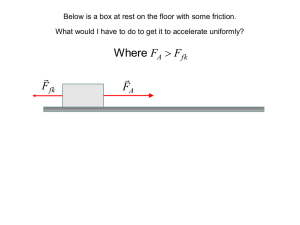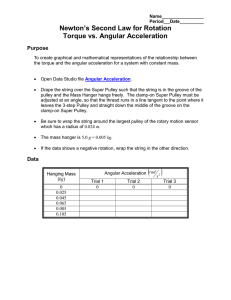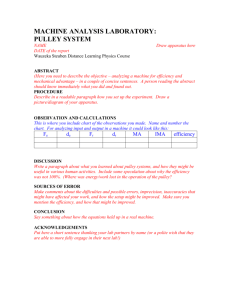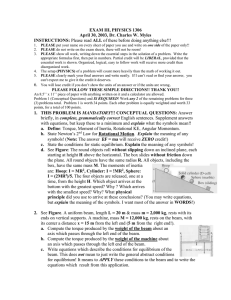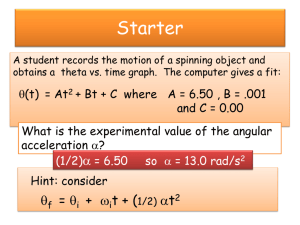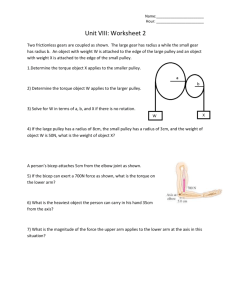FINAL EXAM, PHYSICS 1306
advertisement
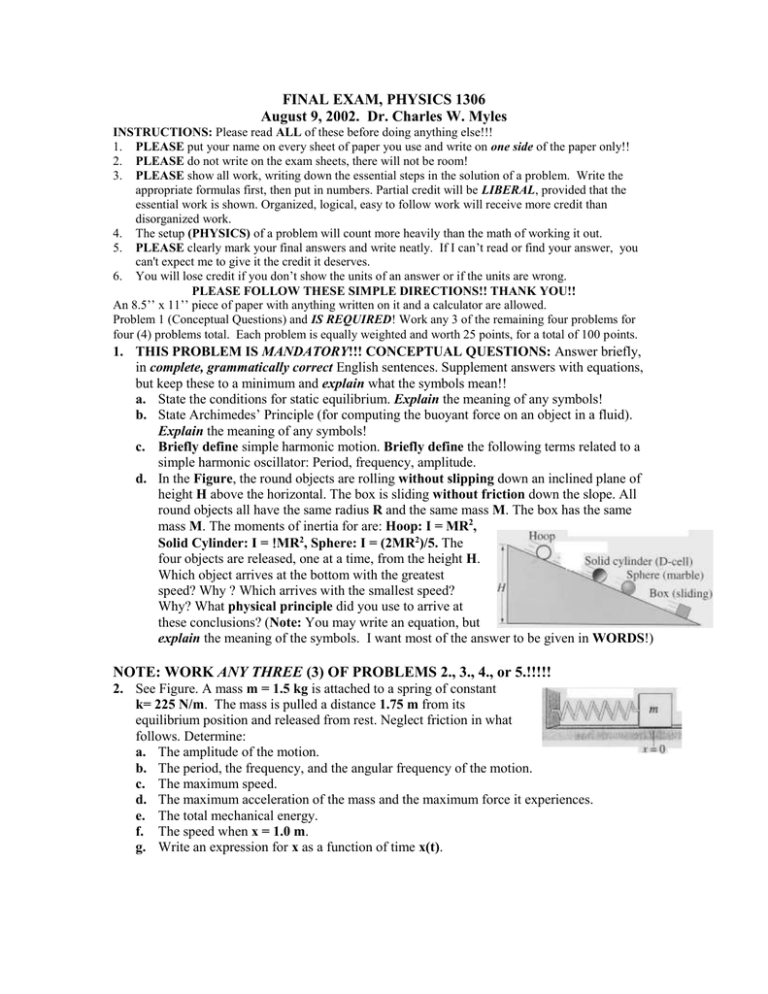
FINAL EXAM, PHYSICS 1306 August 9, 2002. Dr. Charles W. Myles INSTRUCTIONS: Please read ALL of these before doing anything else!!! 1. PLEASE put your name on every sheet of paper you use and write on one side of the paper only!! 2. PLEASE do not write on the exam sheets, there will not be room! 3. PLEASE show all work, writing down the essential steps in the solution of a problem. Write the appropriate formulas first, then put in numbers. Partial credit will be LIBERAL, provided that the essential work is shown. Organized, logical, easy to follow work will receive more credit than disorganized work. 4. The setup (PHYSICS) of a problem will count more heavily than the math of working it out. 5. PLEASE clearly mark your final answers and write neatly. If I can’t read or find your answer, you can't expect me to give it the credit it deserves. 6. You will lose credit if you don’t show the units of an answer or if the units are wrong. PLEASE FOLLOW THESE SIMPLE DIRECTIONS!! THANK YOU!! An 8.5’’ x 11’’ piece of paper with anything written on it and a calculator are allowed. Problem 1 (Conceptual Questions) and IS REQUIRED! Work any 3 of the remaining four problems for four (4) problems total. Each problem is equally weighted and worth 25 points, for a total of 100 points. 1. THIS PROBLEM IS MANDATORY!!! CONCEPTUAL QUESTIONS: Answer briefly, in complete, grammatically correct English sentences. Supplement answers with equations, but keep these to a minimum and explain what the symbols mean!! a. State the conditions for static equilibrium. Explain the meaning of any symbols! b. State Archimedes’ Principle (for computing the buoyant force on an object in a fluid). Explain the meaning of any symbols! c. Briefly define simple harmonic motion. Briefly define the following terms related to a simple harmonic oscillator: Period, frequency, amplitude. d. In the Figure, the round objects are rolling without slipping down an inclined plane of height H above the horizontal. The box is sliding without friction down the slope. All round objects all have the same radius R and the same mass M. The box has the same mass M. The moments of inertia for are: Hoop: I = MR2, Solid Cylinder: I = MR2, Sphere: I = (2MR2)/5. The four objects are released, one at a time, from the height H. Which object arrives at the bottom with the greatest speed? Why ? Which arrives with the smallest speed? Why? What physical principle did you use to arrive at these conclusions? (Note: You may write an equation, but explain the meaning of the symbols. I want most of the answer to be given in WORDS!) NOTE: WORK ANY THREE (3) OF PROBLEMS 2., 3., 4., or 5.!!!!! 2. See Figure. A mass m = 1.5 kg is attached to a spring of constant k= 225 N/m. The mass is pulled a distance 1.75 m from its equilibrium position and released from rest. Neglect friction in what follows. Determine: a. The amplitude of the motion. b. The period, the frequency, and the angular frequency of the motion. c. The maximum speed. d. The maximum acceleration of the mass and the maximum force it experiences. e. The total mechanical energy. f. The speed when x = 1.0 m. g. Write an expression for x as a function of time x(t). NOTE: WORK ANY THREE (3) OF PROBLEMS 2., 3., 4., or 5.!!!!! 3. See Figure. A beam, length L = 40 m, and mass m = 750 kg sits horizontally on two vertical supports. It is uniform, so its weight acts through its center of mass (its center). It supports a machine, mass M = 7500 kg which sits so that its center of mass is 10 m from the right support. The forces on the beam due to the vertical supports are F1 and F2, as shown. a. What torque does the weight of the beam produce about an axis which passes through the left hand support? b. What torque does the weight of the 7500 kg machine produce about this same axis? c. Write equations which describe the conditions for equilibrium of the beam. By this I do not mean to simply write the general conditions for equilibrium. I mean to apply the general conditions for equilibrium to the beam. d. Determine the forces F1 and F2. That is, solve the equations of part c. 4. The pulley in the Figure has mass M = 4 kg and radius R = 0.4 m. Assume that it is a uniform solid disk so that its moment of inertia is I = MR2. A massless cord is wrapped around it and a tension force FT is applied. The pulley starts from rest. After FT has been applied for 6 s, the angular speed has reached = 60 rad/s. a. What is the pulley’s angular acceleration? b. What is the linear (tangential) acceleration of a point on the rim of the pulley? c. What is the net torque acting on the pulley? What physical principle did you use to do this calculation? d. Assuming that FT is the only force producing a torque, calculate FT. e. After 6 s, what are the pulley’s kinetic energy and angular momentum? f. After 6 s, what is the linear velocity of a point on the rim of the pulley? g. After 6 s, what is the radial (centripetal) acceleration of a point on the rim? 5. For a. and b. , see Figure to right. A balloon is filled with just enough helium so that, in air, it will lift a load (excluding the mass of the helium, but including the mass of the empty balloon) of mass m = 1350 kg. Air density: air = 1.29 kg/m3 . Helium density: He = 0.18 kg/m3. a. What volume V of helium is required? b. With that volume, calculate the buoyant force of the air on the balloon (neglecting the volume of the load). For c., d., and e., see figure to right. Water at a pressure of P1 = 4 x 105 N/m2 at street level flows into an office building at a velocity of v1 = 0.85 m/s through a pipe of circular cross section with radius 0.35 m. The pipe tapers down to a radius of 0.15 m by the top floor, a height h = 25 m above the street. Density of water: = 1,000 kg/m3. c. What is the volume flow rate of water in the pipe? d. What is the water’s velocity in the pipe at the top floor? e. What is the water pressure on the top floor? 6. BONUS QUESTION!!!!!!!!! If you were present at the movie shown on Wed., Aug. 7, please write a few short, complete, grammatically correct English sentences telling me what the movie was about. If you do this, I will add five (5) points to your Final Exam grade as a small reward for attending class. If you missed class that day, you will (probably) not know what the movie was about and you will (probably) not be able to answer this. Have a good rest of the summer and good luck in the future!

